A couple of weeks ago, I was fortunate to hitch a ride home from work from the far NE side of the Indy metro region where I currently work. My ride dropped me, along with my bicycle, near the 71st & Binford Ave area. Though the trek was a little long, I was able to conveniently ride my bike home with only minimal on-street interaction with automobiles. My short trip down 71st street to Allisonville Road was the only non-bike facility oriented portion of the trip to South Broad Ripple.
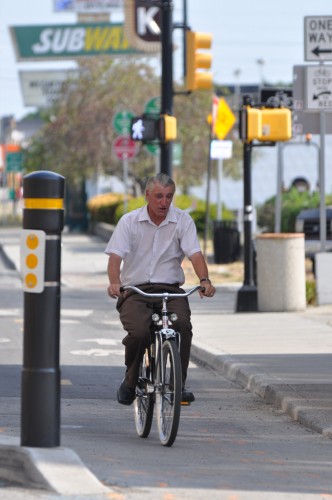
As I was riding, I thought about how convenient this trip was and how low-stress the experience was thanks to the bike lanes; even riding Allisonville Road’s bike lane. In the wider context, it got me thinking about the number of Indianapolis projects going on around town that address non-automobile related mobility projects.

Most of these are bicycle projects but some are pedestrian focused as well. For instance, the 62nd Street Multi Use Path, which Urban Indy has reported on repeatedly, opens up an entire corridor along 62nd street that was previously, 100% automobile oriented. With the completion of this project, cyclists and pedestrians now have a safer trip from Allisonville Road all the way to Broad Ripple via sidewalk, bike lane or bike path.
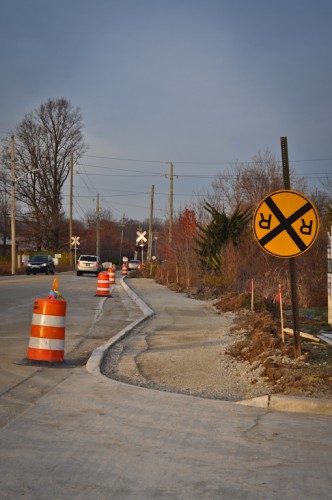
71st Street on the NE side is scheduled to see some similar improvements with a cycling path set to be constructed east of Binford Blvd, and sidewalks to be constructed west, and over the NE Corridor area and into the suburban neighborhood area connecting with an old sidewalk. This will instantly connect hundreds of potential future rail transit riders to not only a possible station there, but the Binford Blvd commercial node in this area.
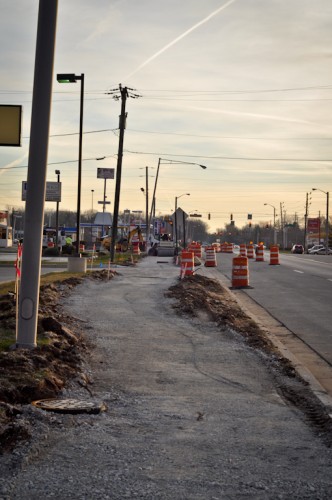
Further south, 52nd street and 46th Street have both benefited from roadway lane reduction and bike lane additions in the last 5 years. Both of these corridors could serve a future NE corridor rail station near Keystone Ave where the rail tracks cross.
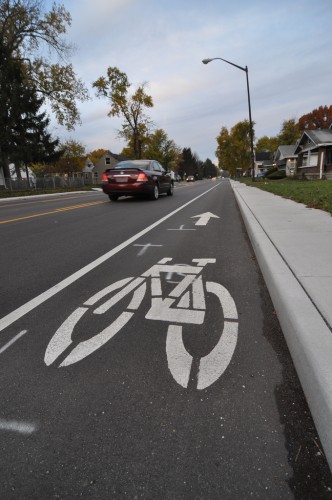
Closer to downtown, Fountain Square has received a tremendous amount of attention when it comes to it’s bicycle and pedestrian infrastructure. Not only has the Cultural Trail been routed through the core of the neighborhood’s commercial center, but a new separated cycle track is open. Additionally, a streetscape project aimed at attracting pedestrians has been underway for a couple of years.
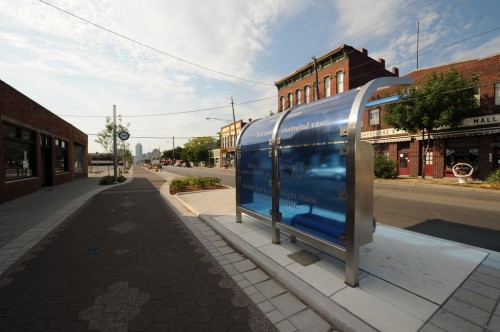
There are a number of other projects going on around town of similar nature that aim to get more people out on bikes or sidewalks. You may be asking what all of this talk about sidewalks and bike lanes has to do with transit. The summation of all of these projects boils down to more access for area residents to take advantage of bus  lines through the neighborhood. It means less sitting in a muddy patch for the bus or walking through grass or even on the street to get to the bus stop.
Simply put, all transit riders are pedestrians.
Providing safe and accessible facilities which promote walking or biking will go a long way towards making people feel comfortable with transit trips and thus, increasing transit mode share.
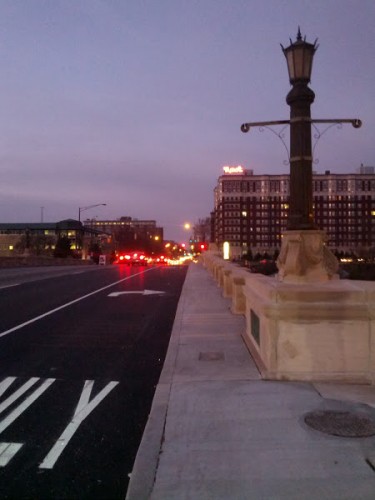
But is the city doing enough? Indianapolis still has a tremendous amount of city streets that lack sidewalks; even within pre-UniGov city limits where development patterns are more urban. That is a valid problem. Additionally, as Kevin (see image above) and Eric have reported, there are a number of recent roadway projects around town which fail to address adequate sidewalk design when rehabilitating our deteriorating roadways & bridges. These are issues which must be properly addressed at DPW.
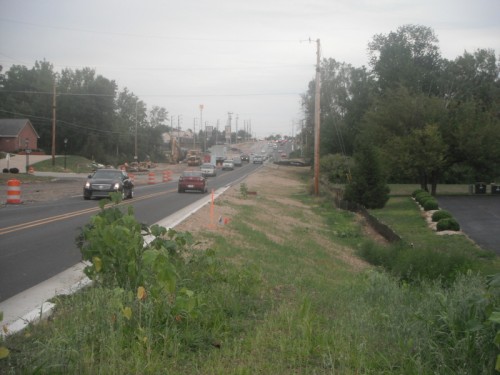
As some of the above examples indicate, the rate with which the city seems to be attacking these connectivity issues is rising. With the  recent adoption of complete streets, hopefully future resurfacing projects will include more sidewalks that are equally respectful of pedestrians and promote safe usage of our public transit system.
Emerson looks impossible to travel, glad I don’t live near there.
That stretch of Emerson is now complete. It is now five lanes wide with a sidewalk on the east side of the road (as it’s been mentioned before that there should be one on the west side of the road.) The intersection of Southport and Emerson is completed but with different forms of pavement making travel through there interesting, and pedestrian access to that whole area is still nearly impossible.
No.
I recently was leaving Meijer down at Southport and Emerson and it was ridiculous how many lanes I had to cross to get from one side westbound Southport to the other. It was two lanes and is now 4 lanes. Completely unnecessary.
Yes. That area is an unmitigated disaster, not improved by the recent projet. Part of the reason that the streets in areas like this need to be widened so much is that there is no grid of streets providing any alternate routes to get to these businesses. It’s the typical suburban development theme, but I don’t really hear too much serious discussion about the need to plat additional streets when areas like this are developed. The only way that streets like these will ever be even marginally safe for pedestrians is if they can be kept narrower with fewer lanes, but that requires more streets. We need more (narrower) streets.
Come out to Franklin Road and Pendleton Pike sometime. To cross from the NE to SW corner of that intersection, one must cross 15 traffic lanes: nine on Pendleton and six on Franklin. (For comparison, a similar crossing at Allisonville & 82nd is 16 lanes.)
The Urban Indy guys know me as an aggressive pedestrian. But even I won’t cross Pendleton on foot. It’s 1000 feet from my office to Hardee’s. In 10 months, I have NEVER walked there. It’s about twice that far to Chase, less than the distance I walked to Chase when I worked on North Meridian. I won’t ever walk there either.
And we wonder why there’s only one IndyGo route in Lawrence…
So even if a bus ran on Pendleton Pike (perhaps displacing a few of the 66,000 cars per day on the Pike), I couldn’t safely use it to get to my office north of the Pike without some pedestrian-friendly alteration to the intersection.
Now, in the Old City where I’ve lived for 25 years…no big problems. But out in the county, there’s a lot to do to be really ready for IndyConnect bus improvements.
It is mathematically impossible for the city to do enough. Debt is destroying this city. And any attempt to do IndyConnect will bankrupt this city. The Ponzi scheme is about to end; they is why Ballard’s puppeteers have him doubling down, with all his outrageous debt wealth transfer schemes. Any transit proposal beyond reorganizing Indygo will end badly.
In many of these mega-intersections (and Southport\Emerson is now part of the ignominious club) the lights don’t stay any one color long enough for a pedestrian to cross the breadth in time, since the roads are now so wide. This barrier is only one out of many in intersections that typically lack pedestrian signals, crosswalks, or basic sidewalks.
I also find it interesting that the construction on Emerson took long enough that a Starbucks franchisee in the little strip mall there decided to close.
Last I checked there’s a Starbucks in the Target across the street and another one on Southport west of I-65, I think people will live. On that note, that exit is the only one I know that has a McDonalds on both sides of the exit. Good ole suburbia!
Point is, we continue to build these monstrosities (Pendleton Pike was a 2007-10 project) even after Indy adopted multimodal design guidelines…honored mostly in Center Twp. where excess capacity makes lane diets easier.
Let’s see if the “complete streets” ordinance results in any significant changes in the first ring out and outside 465.
Just got an IndyGo press release about bus service during the Blizzard of 2012. “Yesterday as most of the city was shut down due to heavy snow and strong winds, IndyGo, Indianapolis’s public transportation service, operated its 30 bus routes and its ADA-compliant paratransit service on a regular weekday schedule with minimal service interruptions. Combined, the local bus and ADA transportation services delivered 11,102 passenger trips.” Yes, there’s plenty we can do to improve IndyGo’s service but let’s take a moment to give ’em credit when they do something right – especially under trying circumstances.
Good for IndyGo! I wonder how many of their regular riders lost a day’s pay with the malls and other businesses being closed. Probably a real bummer for people who trudged through snow to get to the bus and get to work only to find out they were being sent home. I hope that many of them were given a paid holiday, but I’d suspect many were not.
Back on topic, if Indy were doing enough to prepare for improved transit, the Mayor’s office would be in the midst of a public awareness campaign/media blitz to get every homeowner and business owner to get their sidewalks cleared of snow. They would also have adopted a policy of never building new or rebuilt sidewalks without a grass strip between the curb and sidewalk to act as a reservoir for plowed snow. I presume it will likely be weeks until the new sidewalks directly adjacent to W 38th St (between I-65 & I-465) are free of snow, not to mention those along East Washington and many other arterial streets where I saw many pedestrians walking in the vehicular travel lanes today.
Amen. My son, no liberal, pointed out yesterday that in Lafayette and West Lafayette, they actually ticket people who don’t clear their walks and compliance is higher. Since our Code Enforcement department is now ProfitCenterIndy, it seems to me that this is an overlooked revenue stream.
After dark last night, I came very close to hitting a pedestrian preparing to jump down off a 3-foot snowbank onto Pendleton Pike. He was wearing dark clothing, and against the night sky he was invisible.
On Pleasant Run and Ritter, streets with bike lanes, pedestrians were using them as sidewalks (normally only runners do this).
If people can’t safely get to the bus, what good does it do if it runs in the snow?
Clearing sidewalks of snow is a pet peeve of mine, too. While I was shoveling snow from in front of BR Post Office after nearly breaking my neck trying to get in, I was approached by a couple who said that in Minneapolis, there’s a volunteer corps of “code enforcers” who cite offenders for not clearing sidewalks, trash, etc. and the fines are added to property tax bills which tends to guarantee compliance. To this I would add parking vehicles on sidewalks (also against city code but done all the time in the VIllage). The point is well made that if the city is serious about transit, an effort needs to be made to keep transit stops clear of snow & debris. Does IndyGo need a volunteer group along the lines of KIB’s Tree Tenders to undertake such tasks?
The below-grade driveways act like speed humps for the 62nd St Trail. Could’ve been designed much better to encourage biking. And why do engineers think putting a sidewalk as close to the road, or with an integral curb to the road, is going to encourage people that it’s a safe, comfortable environment to walk?
On the sidewalk issue: sometimes it’s a matter that the sidewalk is the “leftover” ROW, and I suspect some of it is a “value engineering” proposition.
On ROW width, for example, North Meridian Street from 12th to Fall Creek is 70 feet wide. The typical cross section is:
6ft. sidewalk/curb
17ft. curb lane (with parking)
12ft. inner lane
centerline
12ft. inner lane
17ft. curb lane (with parking)
6ft. sidewalk/curb
At some intersections, the parking goes away to allow for a left-turn box.
Regarding the “value engineering”: a single curb/sidewalk structure is somewhat cheaper to pour and slightly stronger. And there is no need to backfill a tree strip with any kind of decent soil.
Chris,
You’re probably right on everything you said about there being a slight cost savings, but we need to come to a consensus that a slight cost increase is well worth the money to separate the walkable portion of sidewalks from the curb. Of course, there’s nothing wrong with having a wide sidewalk that comes up to the curb as you expect to see in commercial areas, but a wider sidewalk still leaves room for snow to be plowed without covering the walkable path of the sidewalk. And as we’ve seen downtown, when there is actually any priority for keeping sidewalks clear, snow can actually be trucked away instead of pushed onto the sidewalk.
More often, rather than there being an issue of not enough right-of-way available, the City just builds the sidewalk right at the curb because it’s easier and they don’t have to worry about actually surveying to find out how far back from the curb they can place the sidewalk without going onto private property. We must no longer accept such laziness and lack of attention to detail. We need to demand that the City’s approved Multi-Modal Design Guidelines actually be used.
And I don’t disagree with anything you’ve written here. Probably only in approach.
Many dislike the overall development, but look narrowly at the 16th Street side of the 16th/Meridian CVS.
The sidewalk configuration is something that I pushed for in my former job: extra wide sidewalk pavement with (pre-existing) trees out by the curb.
Now there are three “good examples” in that immediate area: CVS, Supplier Diversity Council (2100 block Meridian), and WISH TV (1900 block Meridian).
Instead of pointing to a set of guidelines, it’s easy to point at “good examples” and say “can you do THAT?”
I think you underestimate the crappy soil that ends up next to streets in construction and reconstruction projects. Most of it, you can’t even dig a hole to plant anything. It is crucial to have good, well-drained soil for street trees, in part so that they can root deeply and not immediately begin displacing pavement with roots.
Chris,
Not to be flip, but I wish you would’ve pushed, or been successful for pushing for the same type of sidewalk configuration on the (arguably more important) Meridian Street side of the CVS. It is an extremely uninviting and unsafe place to walk with a travel lane right at the curb. Obviously, the bus stop has to be up to the curb, but having the walking are for pedestrians being a few feet from traffic is atrocious.
It is great to have good examples to point to, but it seems you’re approach requires that citizens work to get informed of every project in the earliest stages (It’s not easy to get detailed information from DPW) so that specific requests can be made of every project. This approach is virtually impossible. The benefit of using established guidelines is that we can be relatively assured the City will do it right without having to be babysat on every project.
Regarding your comment about the quality of soil placed between sidewalks and curbs: are you suggesting that trees shouldn’t be planted there, that sidewalks should be right next to the curb, or that we should make sure that suitable soil gets filled in between sidewalks and curbs?
I’m suggesting that any requirement to plant trees next to the curb should also consider both buried infrastructure and soil conditions. It isn’t enough to just plop some trees in the ground.
—
I agree that a little more setback from Meridian would have been better there, or inverting the sidewalk and planting areas. But I’ve discussed it with DPW in the past, and they aren’t interested in “public” sidewalks being on private property, and developers typically have to jump through many hoops with financial institutions to dedicate additional ROW.
Also, the RC requirements for Meridian in place at the time dictated the building line at the average of all buildings on the block. In this case, I think the setback is the average of the Apparatus (about 12-14 feet setback) and North Meridian Hardware (zero setback) buildings. I recall planning staff was pretty adamant about establishing a strong corner and being close on the Meridian side.
Again, your comments correctly point out the historical facts. I say we must do much better, therefore, my answer to this post’s question remains an unequivocal “no.” I don’t know what the planning staff considers a “strong corner” but I’d say they sure didn’t get one here. CVS could’ve sited their building identical to Walgreen’s and then built a brick/concrete wall around their parking lot at the corner and the practical effect would have been the same. I’d rather stand on the corner across the street next to Walgreen’s parking lot where at least I can see and be seen, rather than stand next to CVS’s inactive walls guaranteeing that I’ll never see a customer or employee in the store or any customrers going to/from their car. About the only thing that would make standing on the corner next to CVS worse is if Walgreen’s would’ve built their store the same way as CVS.
Is it “practical or reasonable” as per the ordinance to expect a person to shovel a sidewalk let alone tarry with cars and trucks (some carrying hazardous materials) traveling 40mph literally inches from the curb? Or to expect a person to shovel the mound of snow the plows pile on the sidewalk or in front of your driveway?
It infuriates me to no end that DPW is allowed to build sidewalks that are death traps, as a matter of policy. Or ignore repeated requests to make pedestrian safe access a priority – especially for our seniors and children. Does anyone have any suggestions on how to raise awareness?
No, it is neither practical nor reasonable. If one manages to get out before the plows to clear a curb-adjacent sidewalk, the plow will soon deposit a slushy mess on the clear, cold sidewalk…where it will re-freeze into a bumpy and impassable icy mess almost immediately.
This is, as Idyllic points out, entirely a consequence of the failed “curb-adjacent sidewalk” design standard. Perhaps if we stopped calling the grass buffer a “tree lawn” and started calling it “plow-storage buffer”, it would get the traffic-design engineers’ attention. They may not want trees growing next to pavement, but they should understand that the snow has to go somewhere until it melts.
A transit-ready city is also a pedestrian-friendly one; ice-covered sidewalks are unfriendly in the extreme and they force people to walk in the street.
Hear ye, hear ye! I hereby call upon all concerned citizens to immediately demand that snow-plow storage buffers be included between all streets and sidewalks! Go forth, and make our basic pedestrian needs beknownst to all those in power, and yield not til our demands have been met!
Idyllic i can tell you that one voice is not enough – even when it is plainly obvious lives are at stake. All DPW will do is try to ignore you and/or attribute situation to city codes. I believe part of the problem is simple hubris on their part and an overall serious lack of political leadership. Safe pedestrian walkways are a city-wide issue except for certain north-side neighborhoods which to their credit know how to mobilize and be heard.
We have seniors some using wheelchairs who can’t safely cross the street. We have sidewalks and intersections where cars and trucks are traveling up to 50mph within literally inches of you. And then we have a local governmental agency ironically charged with public safety that says unequivocally “we truly don’t care about your personal safety and furthermore there’s not anything you can do about it!!!!
So my question is what can be done to change this mentality? Besides call the Mayor’s Action Center!?!?
Write to your City-County Councilors, all five of them. (Each resident has a district councilor plus four at-large.) Better yet, go to public events and build a sane and reasonable talking relationship with them.
Sadly, Paula is 100% correct. Yet, Chris is correct also.
But how many people will figuratively bang their head against a wall advocating for change for years, when the reward is likely little or no improvement, as Indianapolis’s past history indicates? We can hope that the number of voices will increase and that change will eventually begin to come more quickly. In the meantime, how many talented young people will Indy continue to lose to cities whose governments already understand good urban design and have a history of accountability and public participation in decision making?